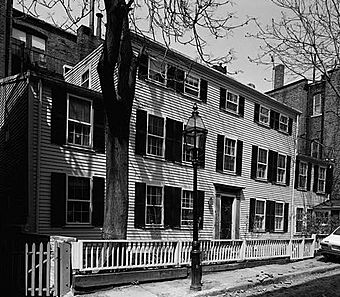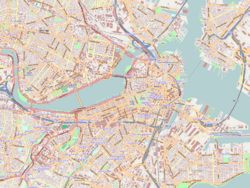William C. Nell House facts for kids
|
William C. Nell House
|
|
|
U.S. Historic district
Contributing property |
|
 |
|
| Location | 3 Smith Court Boston, Massachusetts |
|---|---|
| Built | 1851 |
| Architect | William Lancaster; Benajah Bringham |
| Architectural style | Federal |
| Part of | Beacon Hill Historic District (ID66000130) |
| NRHP reference No. | 76001979 |
Quick facts for kids Significant dates |
|
| Added to NRHP | May 11, 1976 |
| Designated NHL | May 11, 1976 |
| Designated CP | October 15, 1966 |
The William C. Nell House is a historic building at 3 Smith Court in Boston, Massachusetts. It used to be a boarding home. Today, it is a private house.
This house is in the Beacon Hill neighborhood. It is across from the old African Meeting House, which is now a museum. The William C. Nell House is part of the Black Heritage Trail® and the Boston African American National Historic Site walking tours.
The homes on Smith Court show what houses looked like before 1803. They also show how many African Americans lived in Boston at that time. Other houses on Smith Court are also part of the tour. These include 5, 7, 7A, 4, and 2 Smith Court. They are private homes and not open to visitors.
Contents
The House's Design
The building at 3 Smith Court was built between 1798 and 1800. Two white bricklayers built it. It is now known as the James Scott and William C. Nell House.
The front of the house has painted wooden boards called clapboarding. The back of the house is a brick wall with no windows. This style of building was common in Boston before 1803. It was especially common for houses built on narrow alleys.
People Who Lived Here
Starting in 1830, many African American men and their families rented 3 Smith Court.
James Scott's Story
James Scott lived at 3 Smith Court for almost 50 years. He was the person who lived there the longest. He rented the house from 1839 to 1865. Then, he bought the property in 1865 and owned it until he passed away in 1888. Scott was born in Virginia and worked as a clothing seller in Boston.
James Scott helped people escape slavery through the Underground Railroad. This is recorded in the Boston Vigilance Committee's papers. In 1851, Scott was arrested. He was accused of helping to rescue Shadrach Minkins from federal officers. Like John Coburn, whose home is also on the walking tour, Scott was tried and found not guilty.
It is not fully clear if he helped with the Minkins rescue. He was found innocent because there was not enough proof. However, Scott did help other people who had escaped slavery. For example, in 1856, James Scott let Henry Jackson and his family stay at 3 Smith Court. Henry Jackson had escaped slavery and found freedom.
William Cooper Nell's Contributions
William Cooper Nell was an important leader who worked to end slavery. He also rented a part of this house from 1850 to 1857. Nell was one of Boston's strongest supporters for letting all children go to school together. He helped make schools open to everyone in 1855.
Nell wrote several history books, including Colored Patriots of the American Revolution. He also worked for different newspapers and groups that fought against slavery. These included the Liberator, the Massachusetts Anti-Slavery Society, and Frederick Douglass’ Paper. He was also very active in the Boston Vigilance Committee. He helped many people who had escaped slavery by giving them shelter at 3 Smith Court.
William Cooper Nell is known as the first published Black historian in the United States. Because of his important work, the house was named a National Historic Landmark. This means it is a very important historical place.
Smith Court Homes
As early as the 1790s, African Americans began to live on the north side of Beacon Hill. The area around lower Joy Street and Smith Court was a key place for Boston's Black community in the 1800s.
Today, the old homes on Smith Court, along with the African Meeting House and the Abiel Smith School, help us understand the history of African Americans in Boston. These buildings are very well-preserved.
4 Smith Court is a four-story brick building. It shows what homes looked like in Boston between 1885 and 1915. In the 1880s, many new people came to Boston from Eastern and Southern Europe. Many of these new families lived in crowded areas of Boston. These areas included the north side of Beacon Hill, the West End, and the North End. They often moved into neighborhoods that had been partly Black. At the same time, African Americans were moving to other parts of Boston, like Roxbury, Dorchester, and the South End.
Images for kids





